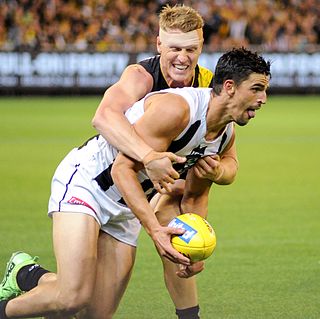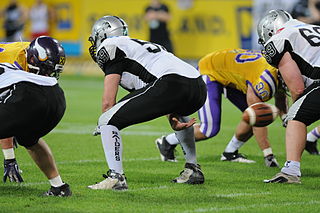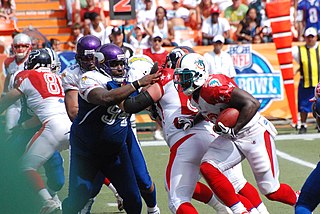Related Research Articles

Most forms of football have a move known as a tackle. The primary purposes of tackling are to dispossess an opponent of the ball, to stop the player from gaining ground towards goal or to stop them from carrying out what they intend.

A snap is the backward passing of the ball in gridiron football at the start of play from scrimmage.

Gridiron football, also known as North American football, or in North America as simply football, is a family of football team sports primarily played in the United States and Canada. American football, which uses 11 players, is the form played in the United States and the best known form of gridiron football worldwide, while Canadian football, which uses 12 players, predominates in Canada. Other derivative varieties include arena football, flag football and amateur games such as touch and street football. Football is played at professional, collegiate, high school, semi-professional, and amateur levels.
In American and Canadian football, pass interference (PI) is a foul that occurs when a player interferes with an eligible receiver's ability to make a fair attempt to catch a forward pass. Pass interference may include tripping, pushing, pulling, or cutting in front of the receiver, covering the receiver's face, or pulling on the receiver's hands or arms. It does not include catching or batting the ball before it reaches the receiver. Once the ball touches any defensive player or eligible offensive receiver, the above rules no longer apply and the defender may tackle the receiver or attempt to prevent them from gaining control of the ball. Once a forward pass is in the air it is a loose ball and thus any eligible receiver – all defensive players are eligible receivers – may try to catch it. When a defensive player catches a forward pass it is an interception and their team gains possession of the ball. Some actions that are defined as pass interference may be overlooked if the defender is attempting to catch or bat the ball rather than focusing on the receiver.
In medicine, a stinger, also called a burner or nerve pinch injury, is a neurological injury suffered by athletes, mostly in high-contact sports such as ice hockey, rugby, American football, and wrestling. The spine injury is characterized by a shooting or stinging pain that travels down one arm, followed by numbness and weakness in the parts of the arms, including the biceps, deltoid, and spinati muscles. Many athletes in contact sports have suffered stingers, but they are often unreported to medical professionals.

The horse-collar tackle is a gridiron football maneuver in which a defender tackles another player by grabbing the back collar or the back-inside of an opponent's shoulder pads and pulling the ball carrier directly downward violently in order to pull his feet from underneath him. The technique is most closely associated with Pro Bowl safety Roy Williams.

In American football, blocking or interference involves legal movements in which one player uses his body to obstruct another player's path. The purpose of blocking is to prevent defensive players from tackling the ball carrier, or to protect a quarterback who is attempting to pass, hand off or run the ball. Offensive linemen and fullbacks tend to do the most blocking, although wide receivers are often asked to help block on running plays and halfbacks may be asked to help block on passing plays, while tight ends perform pass blocking and run blocking if they are not running routes to receive passes. Overall, blocking is a skill that virtually every football player may be required to do at some point, even defensive players in the event of a turnover.

Health issues in American football comprise a large number of health risks associated with participating in the sport. Injuries are relatively common in American football, due to its nature as a full-contact game. Injuries occur during both practice and games. Several factors can affect the frequency of injuries: epidemiological studies have shown older players can be at a greater risk, while equipment and experienced coaches can reduce the risk of injury. Common injuries include strains, sprains, fractures, dislocations, and concussions. Concussions have become a concern, as they increase the risk of mental illnesses like dementia and chronic traumatic encephalopathy (CTE). In individual leagues like the National Football League (NFL) and National Collegiate Athletic Association (NCAA), a public injury report is published containing all injured players on a team, their injury and the game-day status of each player.

A contact sport is any sport where physical contact between competitors, or their environment, is an integral part of the game. For example, gridiron football. Contact may come about as the result of intentional or incidental actions by the players in the course of play. This is in contrast to noncontact sports where players often have no opportunity to make contact with each other and the laws of the game may expressly forbid contact. In contact sports some forms of contact are encouraged as a critical aspect of the game such as tackling, while others are incidental such as when shielding the ball or contesting an aerial challenge. As the types of contact between players is not equal between all sports they define the types of contact that is deemed acceptable and fall within the laws of the game, while outlawing other types of physical contact that might be considered expressly dangerous or risky such as a high tackle or spear tackle, or against the spirit of the game such as striking below the belt or other unsportsmanlike conduct. Where there is a limit as to how much contact is acceptable most sports have a mechanism to call a foul by the referee, umpire or similar official when an offence is deemed to have occurred.
Kyle Kosier is a former American football guard who played in 143 games in the National Football League (NFL) for the San Francisco 49ers, Detroit Lions, and Dallas Cowboys. He played college football at Arizona State University.

High school football, also known as prep football, is gridiron football played by high school teams in the United States and Canada. It ranks among the most popular interscholastic sports in both countries, but its popularity is declining, partly due to risk of injury, particularly concussions. According to The Washington Post, between 2009 and 2019, participation in high school football declined by 9.1%. It is the basic level or step of tackle football.
John Richard Symank was an American college and professional football player who was a defensive back in the National Football League (NFL) for seven seasons during the 1950s and 1960s. Symank played college football for the University of Florida, and thereafter, he played professionally for the Green Bay Packers and St. Louis Cardinals of the NFL. He was later the head coach for Northern Arizona University and the University of Texas at Arlington football teams.
The following terms are used in American football, both conventional and indoor. Some of these terms are also in use in Canadian football; for a list of terms unique to that code, see Glossary of Canadian football.

American football, also known as gridiron football, is a team sport played by two teams of eleven players on a rectangular field with goalposts at each end. The offense, the team with possession of the oval-shaped football, attempts to advance down the field by running with the ball or throwing it, while the defense, the team without possession of the ball, aims to stop the offense's advance and to take control of the ball for themselves. The offense must advance at least ten yards in four downs or plays; if they fail, they turn over the football to the defense, but if they succeed, they are given a new set of four downs to continue the drive. A game is won by the team with the higher number of points, which are scored primarily by advancing the ball into the opposing team's end zone for a touchdown or kicking the ball through the opponent's goalposts for a field goal.

A defensive tackle (DT) is a position in American football that typically lines up on the line of scrimmage, opposite one of the offensive guards; however, he may also line up opposite one of the offensive tackles. Defensive tackles are typically the largest and strongest of the defensive players. Depending on a team's defensive scheme, a defensive tackle may be called upon to fill several different roles. These may include merely holding the point of attack by refusing to be moved, or penetrating a certain gap between offensive linemen to break up a play in the opponent's backfield. If a defensive tackle reads a pass play, his primary responsibility is to pursue the quarterback, or simply knock the pass down at the line if it is within arm's reach. Other responsibilities of the defensive tackle may be to pursue the screen pass or drop into coverage in a zone blitz scheme. In a traditional 4–3 defense, there is no nose tackle. Instead there are a left and a right defensive tackle. Some teams, especially in the National Football League (NFL), have a nose tackle in this scheme, but most of them do not.

Helmet-to-helmet collisions are occurrences in gridiron football when two players' football helmets make head-to-head contact with a high degree of force. Intentionally causing a helmet-to-helmet collision is a penalty in most football leagues, including many high school leagues.
In gridiron football, cut blocking is an offensive line technique that consists of an offensive player knocking a defensive player down by hitting his knees. The technique, which was initially instilled by Bobb McKittrick, the offensive line coach of the San Francisco 49ers from 1979 to 1999, is often criticized as being "dirty." Additionally, it is illegal for an offensive player to "cut" a defensive player already engaged with another offensive player. This is considered a "chop block", not a cut block. In the NCAA, cut blocking is allowed as long as the block is away from the original position of the ball. The Fall Experimental Football League and the NFL banned use of the chop block but the cut block remains a legal block in the NFL.

In gridiron football, the face mask is the part of the helmet that directly covers the face. It is a major source of protection for the players, made of metal covered either with a rubber or plastic coating. Early facemasks were made of pure plastic.
In gridiron football, a chop block is an attempt by an offensive player to cut block a defensive player while the defender is already engaged by another offensive player. The chop block is usually considered illegal and penalized by a loss of 15-yards due to the injury risk it presents to the defender.
A catastrophic injury is a severe injury to the spine, spinal cord, or brain. It may also include skull or spinal fractures. This is a subset of the definition for the legal term catastrophic injury, which is based on the definition used by the American Medical Association.
References
- ↑ Heck, Jonathan F. (2004). "National Athletic Trainers' Association Position Statement: Head-Down Contact and Spearing in Tackle Football". Journal of Athletic Training. 39 (1): 101–111. PMC 385269 . PMID 15085218.
- ↑ Heck, Jonathan F. (March 1996). "The Incidence of Spearing During a High School's 1975 and 1990 Football Seasons". Journal of Athletic Training. 31 (1): 31–37. PMC 1318352 . PMID 16558368.
- ↑ Rakel, David; Rakel, Robert E. (2011). Textbook of Family Medicine (8 ed.). Elsevier Health Sciences. ISBN 9781437735673.